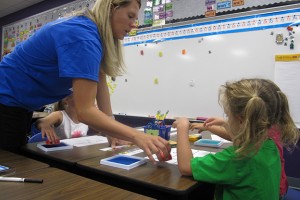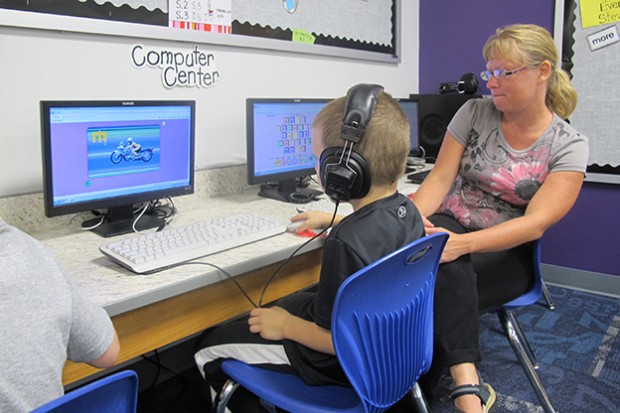Q&A: Assessing Child Progress In The State’s Pre-K Pilot
Indiana’s youngest students are getting a lot of attention these days, perhaps most notably because of the state’s pre-k pilot program. The initiative will target kids from low-income families in five counties during the 2014-15 school year.
Legislators approved more than $10 million dollars for the pre-k pilot, and many say they hope to expand the program statewide. But that will depend on how successful the pilot is in improving student outcomes – and in order to determine success, the state needs data.
They’ll get some of that data from a Kindergarten Readiness Assessment, a test that will be administered to students at each participating provider. The state’s Early Learning Advisory Committee (ELAC) designed the assessment, which the State Board of Education approved just last week.
StateImpact sat down with ELAC member Dr. Megan Purcell, who is also a clinical assistant professor at Purdue University. She explains what the assessment will look like, and how it might differ from what is typically used to determine kindergarten readiness.
- What Constitutes 'Kindergarten Readiness'?Indiana’s youngest students are getting a lot of attention these days, perhaps most notably because of the state’s pre-k pilot program. The initiative will target kids from low-income families in five counties this coming January. The legislation that established the program also calls for a Kindergarten Readiness Assessment. StateImpact Indiana’s Rachel Morello traveled to Lafayette to speak with one of the educators involved in designing that test.Download
Q: What is “kindergarten readiness”? What sort of measurements will teachers look to make using this assessment?

Purdue University
Dr. Megan Purcell is a member of Indiana's Early Learning Advisory Committee, in addition to her duties as a clinical assistant professor in Human Development & Family Studies at Purdue University.
PURCELL: We want to start young children off with the skills that they need, so that they can be more successful than had they not had those skills. We can then identify those that don’t have those skills and provide some intervention, so that that can change. And it sounds weird that ‘we’re going to assess children at this age to be able to determine if they’re going to be successful in third grade,’ but there are certain indicators that we can latch onto.
Q: What are those indicators, and how will the assessment look at them? Walk us through the different parts of the test.
PURCELL: We recommended using what we were affectionately calling a “cocktail” of instruments, a combination of assessment instruments to be able to address the three developmental domains that we felt to be the most significant regarding academic success for primary and elementary school children. So we wanted something addressing in the cognitive domain, that specifically addressed kind of pre-academic readiness skills, which is then where we chose the Bracken School Readiness Assessment instrument. And then we wanted something that addressed language specifically, and that was the Peabody Picture Vocabulary Test, or the PPVT. And then the third piece that we wanted to address was the domain for social and emotional development. And we ended up recommending the social-emotional domain from the ISTAR-KR.
StateImpact notes: The ISTAR-KR is a tool developed by Indiana’s Department of Education, aligned with Indiana Academic Standards. Many pre-k providers actually already use this tool to assess their kids, including Early Learning Indiana, a leading provider in Marion County. Ted Maple, president and CEO at Early Learning, says his teachers use this tool because it is developmentally appropriate for the children they’re assessing.
“To assess kindergarten readiness, obviously preschoolers can’t take a paper/pencil test where they’re filling in bubbles like an ISTEP,” Maple says. “Our teachers observe young children from birth to age five and document what they observe, and then make judgments based on the standards and the skills on the children’s progression through those standards and skills.”
Q: If many providers are already used to giving the ISTAR, why not just continue using that test?
PURCELL: It is solely based on observation notes, and we wanted a combination of observation and what we were calling ‘on-demand,’ So the Bracken and the PPVT satisfied our ‘on-demand’ aspect, the children are showed a stimulus and they have to respond to it. For example, with the Bracken they have to identify colors and letters and numbers and things like that, in a situation like you and I are right now, in this snapshot of time. Versus the ISTAR-KR, which a teacher can be thinking about what the child does in the environment.
StateImpact notes: The specific ELAC recommendation approved by the State Board of Education specifies that “at least” the social-emotional domain of the ISTAR-KR is to be used in this Assessment. If educators wish to include additional domains as well, they can do so at their discretion.
Q: Is it safe to assume the child won’t know they’re being tested, which could affect their performance on those tests?
PURCELL: It should be being conducted by somebody they’re familiar with, which should ease some of that ‘I’m being tested so I’m not going to perform for you as well’ attitude. But also bringing in the ISTAR-KR as observational, where a teacher what the child is doing during everyday routines and activities, will help balance some of that out.
Q: Let’s talk more about the social-emotional domain. The children who will be assessed are very young, and their attitude seemingly changes from minute to minute. How much can you really rely on a measurement like this?
PURCELL: There are certain characteristics that we can see. Are they playing well with others? We joke about that but it’s true that if they’re able to play well with their peers, then they have a skill that some children may not have.vInteractions, conversational skills, play skills, being able to adapt to change…Things along those lines we can be looking at in younger years to then be able to see how can we help focus and filter some of that so that they’re more successful as they age.
Q: The word “assessment” comes up a lot these days, what with the new ISTEP+ on its way, and the word seems to put some people on edge. The kids being assessed here will only be four and five years old. What would you say to reassure folks who are worried about exposing their kids to the world of testing at such a young age?
PURCELL: Again that goes back to our observational and on-demand combination. When you’re using something like the ISTAR-KR, the child will never know they’re being assessed, because they’re not sitting down with the teacher and saying ‘that’s the letter A! That’s the letter D!’ And the way the PPVT and the Bracken are set up, is yes they will have to be more of a one-on-one that would look like a testing situation with a child, but they’re very playful and very short. That was something else we wanted. We wanted something easy, something short, that gave us good data, that the child wouldn’t panic when they were being sat down with their teacher to go over this.
Q: Now that this test has been approved by the State Board of Education, other than helping providers administer it, what’s next on the agenda as far as assessment is concerned?

Rachel Morello / StateImpact Indiana
Educators at participating providers will administer part of the Kindergarten Readiness Assessment directly to their students. The other part will be based on their observations of the child in their environment.
PURCELL: It’s looking at what do we want to do as far as that true statewide implementation. It’s continuing that state study and looking to see what other folks are doing and what we would take from them, what we can apply to our process. Does that mean buying into something we don’t have? Does that mean using what we currently have available to us? Does that mean altering what we have available to us? And so we’ve got to make some of those decisions over the next couple of months.
Indiana’s pre-k pilot program is scheduled to launch in four of the five participating counties in January 2015.

